#richard c. kahn
Explore tagged Tumblr posts
Text
Dread by the Decade: Son of Ingagi
👻 You can support me on Ko-Fi! ❤️

½
Plot: A missing link brought back from Africa terrorizes a pair of newlyweds.
Review: While historically significant as the first horror film to feature an all black cast, Son of Ingagi is, otherwise, a terrible, barely coherent slog.

Year: 1940 Genre: Creature Feature, Sci-Fi Horror Country: United States Language: English Runtime: 1 hour 10 minutes

Director: Richard C. Kahn Writer: Spencer Williams Cinematographers: Roland Price, Spencer Williams, Herman Schopp, Laura Bowman Editor: Dan Milner Cast: Alfred Grant, Daisy Bufford, Zack Williams, Laura Bowman, Spencer Williams

------
Story: 0.5/5 - A mess of sci-fi and mystery cliches worsened by plot holes and uncompelling characters.
Performances: 2/5 - Range from generic to downright stiff and unnatural.
Cinematography: 2.5/5 - While fairly cheap, there are a few imaginative shots used to imply violence.

Editing: 1.5/5
Sets: 2/5 - Obvious sets, but with some attempted diversity.
Costumes, Hair, & Make-Up: 2.5/5 - N'Gina's make-up is extremely underwhelming. The rest of the costumes and make-up are fine.
youtube
Trigger Warnings:
Mild violence
Implied threat of sexual violence
#Son of Ingagi (1940)#Son of Ingagi#Richard C. Kahn#American#creature feature#sci-fi horror#Dread by the Decade#review
5 notes
·
View notes
Text


15 years ago today Turtles Forever premiered on CW4Kids!!!
#CW4Kids#Turtles Forever#tmnt#teenage mutant ninja turtles#leonardo#donatello#raphael#michelangelo#Leo#Donnie#raph#Mikey#Peter Laird#Kevin Eastman#Rob David#Matthew Drdek#Lloyd Goldfine#Roy Burdine#Gary Richardson#Frederick U. Fierst#Alfred R. Kahn#Norman J. Grossfeld#Sarah C. Nesbitt#Richard Kronenberg
1 note
·
View note
Text
Sci-Fi Saturday: Son of Ingagi

Week 21:
Film(s): Son of Ingagi (Dir. Richard C. Kahn, 1940, USA)
Viewing Format: Amazon Streaming
Date Watched: 2024-06-19
Rationale for Inclusion:
Last week I concluded my post on Dr. Cyclops (Dir. Ernest B. Schoedsack, 1940, USA) by noting that I wish I had done more thorough research, or given consideration to additional themes and subgenres, whilst building out the titles for this survey from the silent era through 1940s. While I am not interested in doing posts on films made before 1940 at this point, I did realize a film that I had recently learned about could be inserted into this blog series, despite the fact that in terms of viewings for this survey, my partner and I are well into the 1960s.
What is this exceptional film? One that I originally dismissed because its title made it sound like another derivative horror sequel, Son of Ingagi (Dir. Richard C. Kahn, 1940, USA). I came to discover that it was a film worth including in this survey thanks to watching the documentary Horror Noire: A History of Black Horror (Dir. Xavier Burgin, 2019, USA), which in an early segment explains that Son of Ingagi was the first sci-fi horror film with an all black cast, with a script by Spencer Williams, based on his short story "House of Horror." Given the lack of black people in early American genre cinema it seemed a noteworthy film to include.
Reactions:
My partner and I both went to film school, and spent many hours in our late-teens and early twenties shooting no budget movies with friends and classmates. We consequently have a lot of patience for low budget filmmaking, and had to employ it whilst watching Son of Ingagi. The shots were often staged for ease of long takes, close-ups lacked proper focus or good framing, and some of the performances were rather stiff. Additionally, the copy available on Amazon that we viewed was a standard definition transfer or a mediocre print, which was also unfortunate, but not an uncommon mode of access for independent movies of the 20th century.
The most egregious technical aspect of Son of Ingagi for us though was it was clearly missing a reel. The transition between newlyweds Bob (Alfred Grant) and Eleanor Lindsay (Daisy Bufford) being accused of murdering Dr. Helen Jackson (Laura Bowman) to inheriting her house is jarring. One moment the audience is seeing a flurry of expository newspaper headlines, the next Eleanor is preparing a meal in the kitchen of Dr. Jackson' manor house and chides Bob for having eaten the roast duck she had intended to use for supper. I had to rewatch the transition to verify that one of those headlines does in fact indicate "Lindsay Cleared of Jackson Murder," but it flashes by so quickly at the end of the montage that the audience can scarcely read it.
The newspaper montage is followed by another moment of questionable print integrity. Eleanor chides Bob for eating the roast duck "bones and all", her voice carrying over a blank, gray slug of frames, then Eleanor is suddenly in the manor's office talking to Bradshaw (Earl J. Morris), the executor of Dr. Jackson's will. Luckily, Eleanor explains in that scene that Bob is out at the shop replacing the missing food, which fills in the narrative gap.
The American Film Institute catalog entry lists the film's runtime as 70 minutes, but the transfer available for rent on Amazon.com and viewing on Archive.org only clocks in at 62 minutes. That means that 8 minutes, or slightly under a single reel of 35mm film, is definitely missing from the version that's readily in circulation. In theory, that time would smooth and clarify the jarring, unclear transitions in the version we saw.
Does a complete print of this film still exist? Were those 8 minutes lost to deterioration, damage, or censorship? I wish I knew. I wish I had the time and funding to find out. I hope some archivist is already assembling a grant to do a better, more complete preservation transfer of Son of Ingagi given its importance to American film history.
Despite its technical flaws, Son of Ingagi is a noteworthy film for its era. Race films, or films with all black casts targeted at a black audience, had existed since the silent era and encompassed independent films by black creatives about middle-class, educated black people to films by mainstream Hollywood studios with white creatives and depictions of lower income, Southern accented black stereotypes. Son of Ingagi falls in the center of this spectrum: it's an independent film with a white director, but black screenwriter, and its characters are mostly middle-class types, not caricatures grown out of minstrel shows and D.W. Griffith's questionable sources.
If you are used to seeing early sound films where only token black characters turn up as domestic servants, "exotic" entertainment, menial labor, or comic relief, seeing the opening scenes of Son of Ingagi are a breath of fresh air. The wedding of Bob and Eleanor has a home movie quality in its mundane naturalness. As much contempt as some members of the community have for Dr. Jackson's miserly nature, she's always addressed by her title. (White female doctors aren't always given that respect in mainstream Hollywood productions to this day!) Dr. Jackson's shiftless brother who attempts to steal her fortune, Zeno (Arthur Ray), and the bumbling Detective Nelson (screenwriter Spencer Williams) fit within archetypal roles played by white characters in mainstream Hollywood films. Any negative racial baggage associated with black men playing those types in a mainstream (i.e. dominantly white cast) film is rendered neutral by the all black casting.
And then there's the missing link ape-man that Dr. Jackson apparently brought back from her trip to Africa, along with a fortune in gold, that lives in her secret basement: N'Gina. For viewers today his presence and the lack of exposition around him stands out as surreal in a film that opens as a realistic drama. Granted, as soon as Dr. Jackson's secret basement laboratory, complete with chemistry set, is revealed, it is clear that the film has entered the realm of sci-fi horror in the tradition of Frankenstein or The Strange Case of Dr. Jekyll and Mr. Hyde.
Yet, despite modern write-ups referring to Dr. Jackson as a "mad scientist," she does not fit the pre-established archetype. Yes, she is doing secretive experiments, without peer review, that will supposedly benefit mankind, but she does not act as test subject herself, nor kidnaps unconsenting test subjects, nor traffic in reanimated bodies. N'Gina is not her creation nor prisoner test subject, but more of an acquired, rare pet. Dr. Jackson is not without empathy for others either, as is evident by her choice to help her community via mostly anonymous donations, and the kindness she shows N'Gina when he accidentally cuts himself. Mad scientists tend to be self-centered and insular, with some exceptions. It is more accurate to describe her as an eccentric woman of science than a mad scientist.
In fact, the amazing, but undefined, breakthrough that Dr. Jackson achieves shortly before her death is largely irrelevant beyond being a catalyst in N'Gina going into a homicidal rage. The balance of the film is more concerned with the question of what happened to Dr. Jackson's African gold hoard and N'Gina defending the manor against any outsiders. Frankly, I question if Son of Ingagi should qualify as science fiction at all, since it is closer to a work like the original, short story mystery The Murders in the Rue Morgue by Edgar Allen Poe than the mad scientist infused 1932 film adaptation with Bela Lugosi, The Murders in the Rue Morgue (Dir. Robert Florey, USA).
Granted, in the selection of titles for this survey I deliberately left off King Kong (Dir. Marion C. Cooper and Ernest B. Schoedsack, 1933, USA) and have been quite particular about films that include dinosaurs or other monstrous creatures. Zoology may be a legitimate field of science but gigantic apes and miraculously surviving dinosaurs in narratives without clear technology tie-ins, or atomic intervention, are more like cryptids in my estimation, thus fantasy.
Yet, this line of thinking fails to take into account the iceberg of meaning gerding the film's title: Son of Ingagi. Why is the film titled that when "Ingagi" is neither someone's name nor N'Gina's classification as a creature? The short answer is scientific racism.
An unfortunate consequence of Darwin's Theory of Evolution was white supremacists exploiting it to claim that not only were black people of African decent not the same species as white people of European decent, but that they were evolutionarily closer to apes and monkeys than white people; with other races ranking somewhere in between, but still inferior to whites. None of these assertions were backed by evidence gathered via true scientific method, but they nevertheless shaped (and sadly continue to shape) attitudes about human genetic variation. (For more information on this topic, I recommend Superior: The Return of Race Science by Angela Saini.)
With such theories in circulation, Edgar Rice Burroughs having Tarzan's claim that he was the product of a union between a human man and female ape in the original Tarzan of the Apes (1912) going unquestioned by the shipwrecked party he encounters makes sense. And the belief that apes and humans could procreate together, or at least successfully engage in sexual intercourse, found its way into other popular media narratives, including a 1930 film called Ingagi (Dir. William S. Campbell, 1930, USA).
Ingagi was an exploitation film that falsely claimed to be a documentary during its original release. In addition to relying on unlicensed, existent footage of Africa and footage shot around Los Angeles' Griffith Park Zoo, the filmmakers staged scenes of gorillas (actually men in suits) claiming scantily clad, black African women as sex slaves, supposedly in accordance to a local ritual in the Belgian Congo.
The film was outed as being fake during its theatrical run, but Ingagi was successful enough that it influenced the creation of King Kong and insertion of the mad scientist trying to find a human mate for his pet gorilla plot into the film version of The Murders in the Rue Morgue. White women being molested by apes in these films has been read by critics as having bestiality presented in the place of miscegenation, thus black men erotically menacing white women, in accordance with a favorite stereotype of white supremacists.
With that cultural milieu for context, the decision to title the film adaptation of Spencer Williams' "House of Horror" "Son of Ingagi" was a deliberate choice to capitalize on and engage with the racialized fad of killer ape movies. That being the case, the audience was meant to infer that N'Gina was not simply a missing link ape-man, but the product of a human-ape coupling thus the son of the women fetishizing gorillas from Ingagi, which incidentally is apparently the Ikinyarwanda word for "gorilla."
Son of Ingagi consciously operating with the subtext of scientific racism does add more legitimacy to its classification as science fiction. I still would be more apt to file it under "mystery" or "horror," while the AFI catalog takes the broad view that Son of Ingagi is a "comedy-drama," but regardless of metadata choice it is a fascinating cultural artifact. I am glad that I spent the time to view and unpack it, and do genuinely hope a more complete restoration turns up in the near future.
4 notes
·
View notes
Text
Mai MMXXIII
Films
Quand la Panthère rose s'emmêle (The Pink Panther Strikes Again) (1976) de Blake Edwards avec Peter Sellers, Herbert Lom, Leonard Rossiter, Colin Blakely, Lesley-Anne Down, André Maranne, Michael Robbins et Burt Kwouk
Le Dimanche de la vie (1967) de Jean Herman avec Danielle Darrieux, Jean-Pierre Moulin, Olivier Hussenot, Françoise Arnoul, Berthe Bovy, Anne Doat, Hubert Deschamps et Jean Rochefort
Romance inachevée (The Glenn Miller Story) (1954) de Anthony Mann avec James Stewart, June Allyson, Henry Morgan, Charles Drake, George Tobias et Barton MacLane
La Canonnière du Yang-Tsé (The Sand Pebbles) (1966) de Robert Wise avec Steve McQueen, Richard Attenborough, Richard Crenna, Candice Bergen, Marayat Andriane et Makoto Iwamatsu
Deux Heures moins le quart avant Jésus-Christ (1982) de Jean Yanne avec Coluche, Michel Serrault, Jean Yanne, Michel Auclair, Françoise Fabian, Mimi Coutelier et Darry Cowl
Le Dernier Voyage (2020) de Romain Quirot avec Hugo Becker, Paul Hamy, Lya Oussadit-Lessert, Jean Reno, Bruno Lochet et Émilie Gavois-Kahn
Le Dernier Métro (1980) de François Truffaut avec Catherine Deneuve, Gérard Depardieu, Heinz Bennent, Jean Poiret, Andréa Ferréol, Paulette Dubost, Jean-Louis Richard et Maurice Risch
Les cadavres ne portent pas de costard (Dead Men Don't Wear Plaid) (1982) de Carl Reiner avec Steve Martin, Rachel Ward, Carl Reiner, Reni Santoni, George Gaynes, Barbara Stanwyck, Ava Gardner, Burt Lancaster, Humphrey Bogart, Cary Grant et Ingrid Bergman
Docteur Folamour ou : comment j'ai appris à ne plus m'en faire et à aimer la bombe (Dr. Strangelove or: How I Learned to Stop Worrying and Love the Bomb) (1964) de Stanley Kubrick avec Peter Sellers, George C. Scott, Sterling Hayden, Keenan Wynn, Slim Pickens, Peter Bull et Tracy Reed
Un homme est passé (Bad Day at Black Rock) (1955) de John Sturges avec Spencer Tracy, Robert Ryan, Anne Francis, Dean Jagger, Walter Brennan, John Ericson, Ernest Borgnine et Lee Marvin
Le Monde, la Chair et le Diable (The World, The Flesh and the Devil) (1959) de MacDougall avec Harry Belafonte, Inger Stevens et Mel Ferrer
La Belle Saison (2015) de Catherine Corsini avec Izïa Higelin, Cécile de France, Noémie Lvovsky, Kévin Azaïs, Lætitia Dosch et Benjamin Bellecour
Le Grand Embouteillage (L'ingorgo) (1979) de Luigi Comencini avec Annie Girardot, Fernando Rey, Miou-Miou, Gérard Depardieu, Ugo Tognazzi, Marcello Mastroianni, Stefania Sandrelli, Alberto Sordi, Orazio Orlando, Gianni Cavina, Harry Baer et Ángela Molina
Ariane (Love in the Afternoon) (1957) de Billy Wilder avec Gary Cooper, Audrey Hepburn, Maurice Chevalier, Van Doude, John McGiver et Lise Bourdin
Voici le temps des assassins (1956) de Julien Duvivier avec Jean Gabin, Danièle Delorme, Gérard Blain, Lucienne Bogaert, Germaine Kerjean, Gabrielle Fontan et Jean-Paul Roussillon
Séries
Castle Saison 1, 2
Des fleurs pour ta tombe - Jeunes Filles au père - Amis à la vie, à la mort - Sexe, Scandale et Politique - Calcul glacial - La Piste du vaudou - Crimes dans la haute - Mémoires d’outre-tombe - Où est Angela ? - Double face - La Mort à crédit - Quitte ou Double - L'Enfer de la mode - L'Escroc au cœur tendre - L'auteur qui m'aimait - Pour l'amour du sang - Dernières paroles
Coffre à Catch
#113 : Unforgiven 2008 : Matt Hardy will not die ! - #114 : Matt Hardy champion, les débuts de Jack Swagger ! - #115 : La ECW, c'est bien, mais avec Vianney c'est mieux ! - #116 : Maryse : Pourquoi es-tu si belle? - # 117 : All Star Main Event + Gérard Lenorman !
James May : Notre Homme au Japon
Allez ! - Chou farci - Déodorant - Salut Bim ! - Le garçon de la pêche - Prune salée
Friends Saison 8
Celui qui venait de dire oui - Celui qui avait un sweat rouge - Celui qui découvrait sa paternité - Celui qui avait une vidéo - Celui qui draguait Rachel - Celui qui perturbait Halloween - Celui qui voulait garder Rachel - Celui qui engageait une strip-teaseuse - Celui qui avait fait courir la rumeur - Celui qui défendait sa sœur - Celui qui ne voulait pas aller plus loin - Celui qui passait une soirée avec Rachel - Celui qui découvrait les joies du bain - Celui qui découvrait le placard secret - Celui qui visionnait la vidéo de l'accouchement - Celui qui avouait tout à Rachel - Celui qui voyait dans les feuilles de thé - Celui qui était trop positif
Inspecteur Barnaby Saison 8
Un cri dans la nuit - Les Régates de la vengeance - Requiem pour une orchidée - Pari mortel - Double vue - Le Saut de la délivrance - L'assassin est un fin gourmet - Rhapsodie macabre
L'agence tous risques Saison 4, 5
Qui est qui ? - Cowboy George - La roue de la fortune - Services en tous genres - Club privé - Harry a des ennuis - Un monde de fou - La mission de la paix - Les orages du souvenir - Un témoin capital : 1re partie - Condamnation : 2e partie - Exécution : 3e partie - Match au sommet - Théorie de la révolution - Mort sur ordonnance - Une vieille amitié
Columbo Saison 2
Rançon pour un homme mort - Requiem pour une star
Les Petits Meurtres d'Agatha Christie Saison 3
Jusqu'à ce que la mort nous sépare - Meurtres du troisième type
Affaires Sensibles
Algues vertes : le danger qui empoisonne la Bretagne - James Jesus Angleton : paranoïa à la CIA - THE GRIM SLEEPER : Le faucheur en embuscade 1985-2007 - La création du festival de Cannes - 2000, les Jeux paralympiques de Sydney : la fraude des basketteurs espagnols
Bardot
Une enfant sage - B.B - La Madrague - Le papillon - Bébé - La vérité
Les Enquêtes de Morse saison 9
Mascarade - Prélude - Sorties de scène
James May's Cars of the People Saison 1, 2
Transports et totalitarisme - Rien n'arrête les nouilles - Les voitures qui nous ont toujours fait rêver - La puissance de la vapeur - 4x4 - Boom (et effondrement) d'après-guerre
The Grand Tour Saison 4, 3, 1, 2
The Grand Tour présente… Seamen - The Grand Tour présente… La Chasse au trésor - Eaux salées et eaux douces - The Grand Tour: A Scandi Flick - Virée à l’Italienne - Spéciale Colombie : Première partie - Spéciale Colombie ; Deuxième partie - Oh, Canada - Coup de vieux
Livres
Orage de chaleur de Richard Castle
Cinq Gars pour Singapour de Jean Bruce
Lucky Luke, tome 27 : Le 20ème de cavalerie de Morris et René Goscinny
Garôden de Jirô Taniguchi et Baku Yumemakura
Une enquête du commissaire Dupin : Etrange printemps aux Glénan de Jean-Luc Bannalec
Détective Conan, tome 9 de Gôshô Aoyama
Il était une fois… Le cinéma, Tome 1 : Des frères Lumière à Charlie Chaplin de Jean-Pierre Georges et Dentiblu
3 notes
·
View notes
Photo
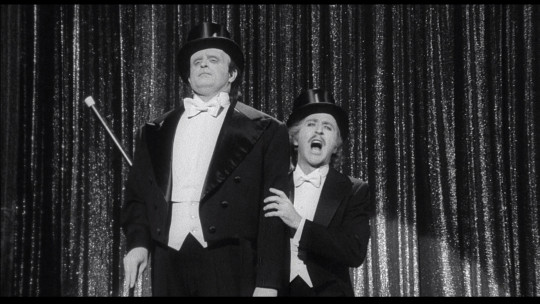
Peter Boyle and Gene Wilder in Young Frankenstein (Mel Brooks, 1974)
Cast: Gene Wilder, Peter Boyle, Marty Feldman, Madeline Kahn, Cloris Leachman, Teri Garr, Kenneth Mars, Richard Haydn, Gene Hackman. Screenplay: Gene Wilder, Mel Brooks. Cinematography: Gerald Hirschfeld. Production design: Dale Hennesy. Film editing: John C. Howard. Music: John Morris.
A blissful comedy, laden with wonderful musical moments like the great "Puttin' on the Ritz" number and Madeline Kahn bursting into an orgasm-induced rendition of "Ah, Sweet Mystery of Life" as Jeanette MacDonald never sang it. But the score by John Morris is great on its own, as in the serenade to the monster on violin and horn played by Frederick (Gene Wilder) and Igor (Marty Feldman). And even the gag references sing: Frederick's appropriation of Mack Gordon's lyrics to "Chattanooga Choo Choo" when he arrives at the Transylvania (get it?) Station, or the supposedly virginal Elizabeth (Kahn) singing "The Battle Hymn of the Republic." It's also surprising how little really smutty humor Brooks indulges in this time. There's Inga's (Teri Garr) appreciation of the monster's "enormous schwanzstucker," to be sure, but this is PG humor at worst. So many of the gags are just wittily anti-climactic, like Frau Blucher (Cloris Leachman) proclaiming that Victor Frankenstein "vas my ... boyfriend!" Or the Blind Man (Gene Hackman) wistfully calling out to the fleeing monster, "I was gonna make espresso." (Hackman ad-libbed this line, and many other gags in the film, such as Igor's peripatetic hump, were improvised by the actors.) Has a spoof ever been so beautifully staged? The production design is by Dale Hennesy, who had the wit to track down and borrow the original sparking and buzzing laboratory equipment that Kenneth Strickfaden created for the first Frankenstein (James Whale, 1931). The equally evocative black-and-white cinematography is by Gerald Hirschfeld.
4 notes
·
View notes
Text
In Venice Beach, naive Midwesterner JB bonds with local slacker KG and they form the rock band Tenacious D. Setting out to become the world’s greatest band is no easy feat, so they set out to steal what could be the answer to their prayers… a magical guitar pick housed in a rock-and-roll museum some 300 miles away. Credits: TheMovieDb. Film Cast: JB: Jack Black KG: Kyle Gass Lee: JR Reed Dio: Ronnie James Dio Open Mic Host: Paul F. Tompkins Lil’ JB: Troy Gentile Security Guard: Ned Bellamy Security Guard: Fred Armisen Car Chase Cop / Gang Leader: Kirk Ward Truck Stop Waitress: Amy Poehler The Stranger: Tim Robbins Satan: Dave Grohl Guitar Center Guy: Ben Stiller Girl: Lara Everly Girl: Brittany Eldridge Girl: Melissa-Anne Davenport Gang Member: John Ennis Gang Member: V.J. Foster Gang Member: Jay Johnston Drunk Frat Dude: Colin Hanks Al’s Bar Waitress: Stephanie Erb Gorgeous Woman: Amy Adams Tattooed Biker: Milos Milicevic Ecstatic Woman: Molly Bryant Poopy Guy: Michael Rivkin Stand Up Comic: Gregg Turkington Exploding Head Guy: Patrick M. Walsh Fainting Woman: Bevin Kaye KG’s Mother: Evie Peck Young KG: Mason Knight Bully: Erik Walker Betty Black: Cynthia Ettinger Billy Black: Andrew Lewis Caldwell Tarot Card Reader: Laura Milligan Frat Boy #1 (uncredited): Jason Segel Bud Black (uncredited): Meat Loaf Sasquatch (uncredited): John C. Reilly Film Crew: Casting: Jeanne McCarthy Executive Producer: Georgia Kacandes Songs: Jack Black Stunts: Jack Gill Executive Producer: Ben Stiller Original Music Composer: John King Makeup Designer: Barney Burman Second Unit Director of Photography: Paul Hughen Supervising Sound Editor: Elmo Weber Stunt Double: Cole S. McKay Visual Effects Supervisor: David D. Johnson Casting: Juel Bestrop Executive Producer: Cale Boyter Stunts: Mic Rodgers Songs: Kyle Gass Writer: Liam Lynch Producer: Stuart Cornfeld Editor: David Rennie Executive Producer: Toby Emmerich Executive In Charge Of Production: Erik Holmberg Second Assistant Director: Heather Grierson Production Design: Martin Whist Sound Effects Editor: Derek Vanderhorst Director of Photography: Robert Brinkmann Executive Producer: Richard Brener Original Music Composer: Andrew Gross Second Unit Director: Rick Avery Supervising Sound Editor: David Bach First Assistant Director: Milos Milicevic Stunts: Doug Coleman Stunts: Tim Trella Stunt Driver: Angelique Midthunder Art Department Coordinator: Mike Piccirillo Stunts: Robert Chapin Set Decoration: Don Diers Costume Designer: Dayna Pink Stunts: Terry Jackson Stunt Double: John Ashker Special Effects Makeup Artist: Toni G Stunts: Tom Elliott Special Effects Makeup Artist: Justin Stafford Special Effects Makeup Artist: Mike Smithson Stunt Double: Rick Miller Stunts: Larry Rippenkroeger Stunts: Sean Graham Art Direction: Maria Baker Stunts: Ian Quinn Script Supervisor: Pamela Alch Stunts: Brian Machleit Sound Effects Editor: Clayton Weber Still Photographer: Zade Rosenthal Stunts: Frank Torres Aerial Director of Photography: David B. Nowell Hair Department Head: Linda D. Flowers Key Hair Stylist: Merribelle Anderson Makeup Artist: Ralis Kahn Hairstylist: Yeşim “Shimmy” Osman Sound Effects Editor: Marc Glassman Visual Effects: Brent M. Bowen Camera Operator: Michael FitzMaurice Sound Effects Editor: Orada Jusatayanond Costume Supervisor: Hope Slepak Stunts: Dean Bailey Stunts: Eliza Coleman Makeup Department Head: Kate Shorter Stunt Coordinator: Scotty Richards Production Supervisor: Ralph Bertelle First Assistant Camera: Thomas Vandermillen Stunt Coordinator: Brian Avery Visual Effects: John Coats Stunts: Kevin Abercrombie Special Effects Makeup Artist: Scott Stoddard Stunts: Joni Avery Stunt Driver: Ed McDermott II Special Effects Makeup Artist: Michael Marino Second Second Assistant Director: Velvet Andrews-Smith Steadicam Operator: Jon Myers Stunt Driver: Jody Hart Stunts: Roger Richman Second Second Assistant Director: Ivan Kraljević Stunts: Danny Wynands Stunts: Jeff Brockton Stunt Double: Tad Griffith Stunts: Buck McDancer Special Effects Coordinator: Andy Weder Stunt...
0 notes
Text
Birthdays 2.20
Beer Birthdays
Kasper George Schmidt (1833)
Joseph F. Hausmann (1887)
Five Favorite Birthdays
Ansel Adams; photographer (1902)
Robert Altman; film director (1925)
Sidney Poitier; actor (1924)
Lew Soloff; trumpet player (1944)
Jimmy Yancey; jazz pianist (1898)
Famous Birthdays
Edward Albert; actor (1951)
Lauren Ambrose; actor (1978)
Charles Barkley; Philadelphia 76ers F (1963)
Walter Becker; pop musician (1950)
Andrew Bergman; film director (1945)
George Bernanos; French writer (1888)
Brenda Blethyn; actor (1946)
Kurt Cobain; singer, songwriter (1967)
Cindy Crawford; model (1966)
Sandy Duncan; actor (1946)
Phil Esposito; Boston Bruins C (1942)
Ibrahim Ferrer; Cuban musician (1927)
Jerome "J." Geils; rock guitarist (1946)
Kelsey Grammar; actor (1955)
Angelina Grimke; abolitionist, suffragist (1805)
Patty Hearst; publishing heiress (1954)
Joel Hodgson; comedian (1960)
Karel Janacek; composer (1903)
Louis Kahn; architect (1901)
Mike Leigh; film director (1943)
Jennifer O'Neill; actor (1948)
Roger Penske; auto driver (1937)
William "don't fire until you see the white's of their eyes" Prescott; revolutionary war soldier (1726)
Bob "Vaulting Vicar" Richards; pole-vaulter (1926)
Rihanna; singer (1988)
Buffy Sainte-Marie; singer, songwriter (1941)
Serena; porn actor (1951)
Andrew Shue; actor (1967)
Patricia Smith; actor (1930)
Carl Stotz; father of little league (1910)
Peter Strauss; actor (1947)
Imogen Stubbs; actor (1961)
Lily Taylor; actor (1967)
Bobby Unser; auto racer (1934)
Gloria Vanderbilt; dashion designer (1924)
Cornelius Vanderbilt Whitney; businessman (1899)
Julia Volkova; pop singer, "t.A.T.u." (1985)
0 notes
Text
1.11.24
Thursday, January 11th. Today's lecture was pre-recorded and we reviewed Bree Newsome's "Wake," Richard C. Kahn's "Son of Ingagi," W.E.B Du Bois' "The Comet," and a little bit of the Horror Noire Documentary. There were conversations about Respectability Politics, Domestic Fear, and The Great Payback. We looked at Son of Ingagi through the perspective of rebuke, reframing, and reclamation. We also noticed themes of music, parties, and dancing within black horror films.
Regarding The Comet, It's exciting to think of a world uninhibited by racial constructions. Still, I'm intrigued that Du Bois focuses on the relationship between a black man and a white woman...
0 notes
Photo
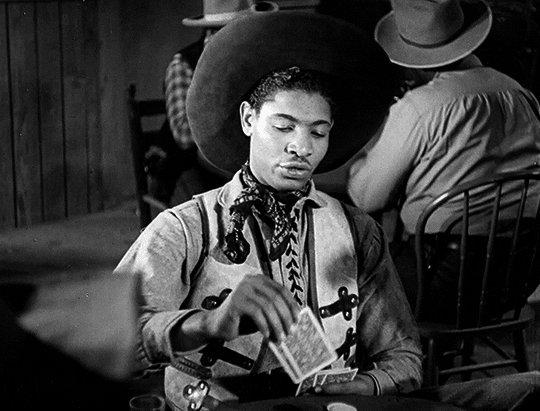


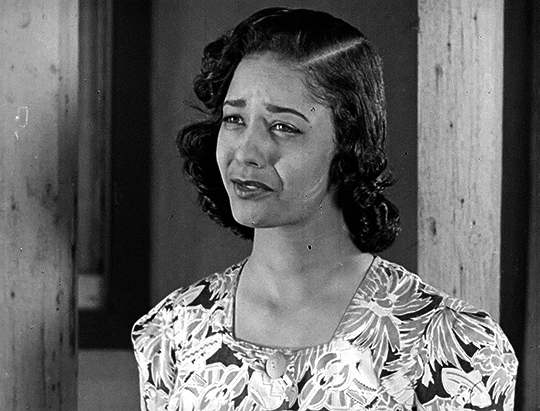
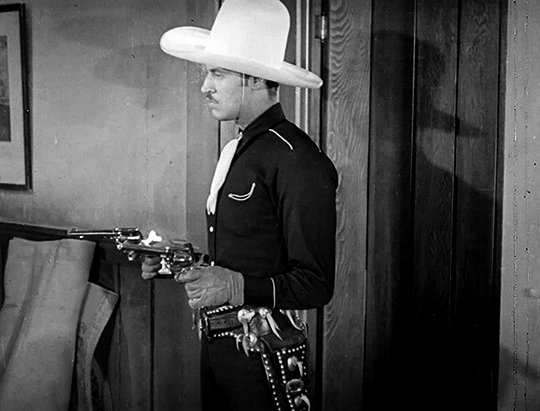

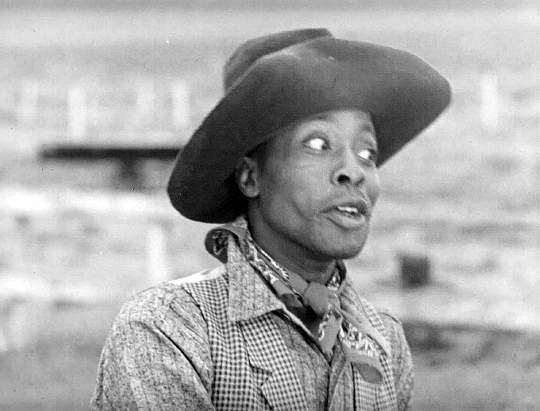
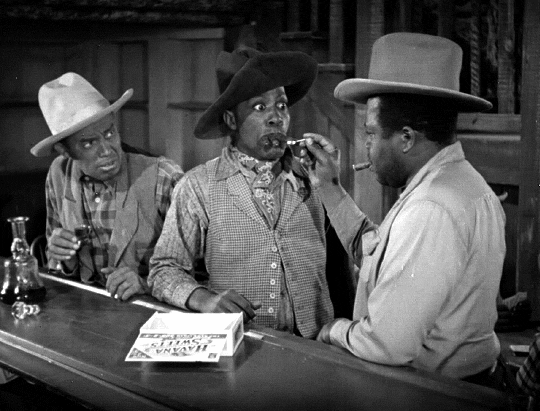

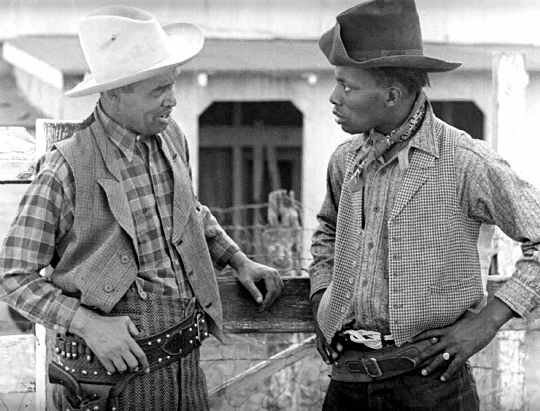
THE BRONZE BUCKAROO (1939) dir. Richard C. Kahn
#oldhollywoodedit#classicfilmedit#filmedit#classicfilmblr#classicfilmsource#cinemaspam#filmgifs#moviegifs#cinemapix#userstream#chewieblog#mygifs*#bronzebuckaroo*#the bronze buckaroo#herb jeffries#artie young#richard c. kahn#1939#1930s
4K notes
·
View notes
Photo
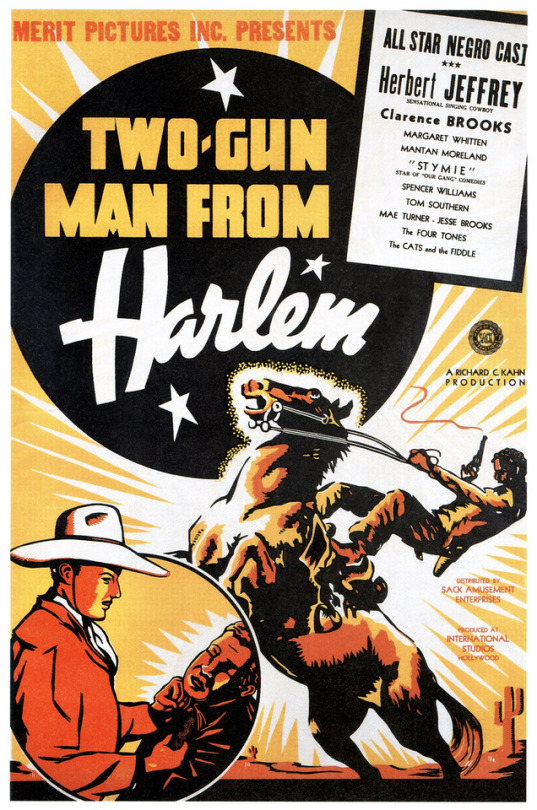
Herb Jeffries, The First Black Western Star by Raquel Stecher
“Representation matters” is a common phrase used today among film critics. While it’s considered a more modern idea, a backlash against many years of misrepresentation, one early pioneer in the 1930s saw this problem and came up with an idea to fix it. That man was Herb Jeffries.
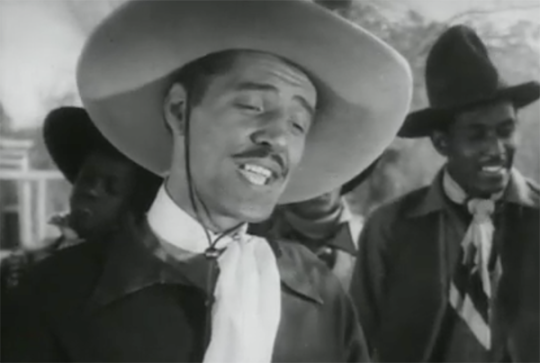
Born in Detroit in 1913, Jeffries’s heritage represented the city’s melting pot of ethnicities including African, Italian, French, Jewish, Native American and Irish. It wasn’t until he left his community that he saw the adverse effects of segregation. Too dark to pass as white, Jeffries decided to present as black and pursue a career in blues and jazz where African-American artists were thriving. Jeffries had a deep voice, incredible vocal pitch and larger-than-life presence making him a born performer. He made his way across the country performing in New York and Chicago before finally landing in Hollywood where he met small-time movie producer Jed Buell.
Jeffries and Buell collaborated on what would become the first ever all-black Western, Harlem on the Prairie (1937). The inspiration came from Jeffries’ childhood memories of watching Westerns starring Tom Mix. The genre was devoid of black characters and Jeffries knew he could make a difference. A bit of inspiration also came from Buell himself who produced The Terror of Tiny Town (1938), a Western featuring a cast entirely comprised of little people. With the singing cowboy movement (made popular by Gene Autry) in full swing it seemed fitting for Buell and Jeffries to make a Western musical.
Buell worried that Jeffries’ pale complexion would not carry over well to black audiences. In an interview with KCETV’s Huell Howser, Jeffries said “we had trouble finding African Americans who could ride, sing and act. We tested 10 or 12 and none could do all three. But I could.” Having spent much time at his grandfather’s ranch in Ohio, Jeffries had extensive experience riding horses and lassoing ropes. Harlem on the Prairie was an instant smash. The intention was to expand the scope of what African-American actors could portray on screen by means of an all-black production, catering to black audiences and screened at black theaters. This film was successful enough that it also screened in mainstream cinemas across the country.
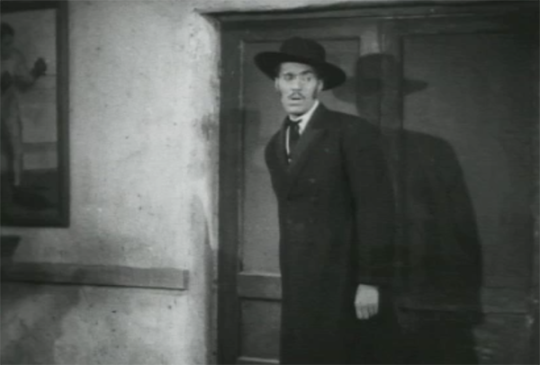
When Buell moved on to other projects, Jeffries found a new collaborator in director/producer Richard C. Kahn. They worked on three films together: TWO-GUN MAN FROM HARLEM (’38), The Bronze Buckaroo (1939) and Harlem Rides the Range (1939). These stories were adaptations of existing Westerns written by Fred Myton, retooled with different character names and added dialogue. There was no room in the budget for any additional help so it was all hands on deck. Cast members were responsible for their own stunts, Kahn worked on the screenplays and Jeffries wrote his own songs. Jeffries often joked that these were “C-pictures” because of their low-production value. Appearing with Jeffries on screen was his musical quartet The Four Tones.
Jeffries took his intended audience quite seriously. He wanted these films to be true to the Western genre while also being suitable for children. Kids weren’t interested in romance so that was toned down. In his interview with Howser, Jeffries said, “we were careful not to smoke… when we shot a guy we made sure he was the villain. Good citizens were out doing the right thing.” This foresight paid off. As he remembered, “wherever I went kids would follow me through the street, not only black kids but white kids too.”
Jeffries’ films were sometimes criticized for perpetuating black stereotypes. TWO-GUN MAN FROM HARLEM was a notable exception. The story follows Bob Blake, a ranch man falsely accused of killing a man. He’s been set up by the man’s widow, a cheating housewife caught up with a local mob syndicate. She switches Blake’s gun for the murder weapon, hence the “two-gun” reference in the title. Blake travels to Harlem, takes on the appearance of a preacher/gangster and travels back home to solve the crime under his new disguise. Along the way there are plenty of musical performances including a rendition of “I’m a Happy Cowboy”. Mantan Moreland serves as comic relief, Marguerite Whitten as a romantic interest and child actor Matthew “Stymie” Beard as a relatable figure for young audiences. What’s interesting about the quartet is that there are no white characters. Not only that, but there are no Native Americans or Mexicans either. Bob Blake is his own savior, coming to his own rescue without the help of more empowered white characters.
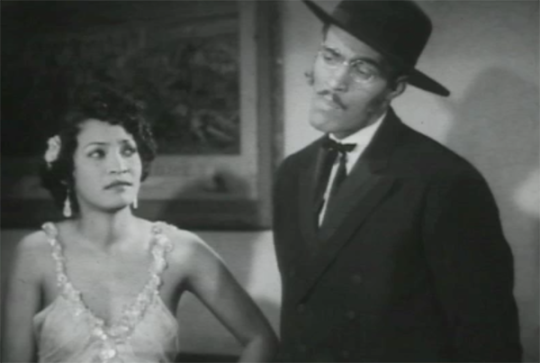
To promote TWO-GUN MAN FROM HARLEM and the other Bob Blake films, Jeffries and The Four Tones toured the South. Jeffries would ride around in his Cadillac, adorned with steer horns and his name emblazoned on the side. After screenings at black theatres, Jeffries would perform musical numbers on stage with the quartet and do cowboy tricks much to the audience’s delight. By 1939, there was a decline in black theatres and a shrinking market. Jeffries was happy to leave his career as a cowboy movie star behind when Duke Ellington invited him to join his band. He reminisced, “I was making movies, but I knew I’d rather sing with Ellington.” Until his death in 2014 at the ripe old age of 100, Jeffries could be regularly seen wearing his Stetson hat and cowboy boots and would often proclaim “I’ll always be a cowboy.”
162 notes
·
View notes
Link

#ingagi#son of ingagi#richard c. kahn#spencer williams#zack williams#laura bowman#alfred grant#sequel#creature#monster#united states#daisy bufford#arthur ray#earle morris#jesse graves#the four toppers#horror#horror film#horror films#horror movie#horror movies#horror fan#horror fans#horror review#horror reviews#horror reviewer#film review#film reviews#film reviewer
0 notes
Text
Son of Ingagi (1940)
Writtten by Spencer Williams (Andy of Amos n' Andy) based on a short story he'd written, Son of Ingagi is purportedly the first horror/science fiction movie with an all black cast (the director was white). It's on par with (maybe even slightly better than) the low budget Poverty Row man-in-a-costume (this one looks like a modified gorilla which already marks it as attempting to be more original than the slew of gorilla suit movie in early U.S. cinema) creature movies being churned out at the time, with reasonably good performances and a fair dose of humor.
Son of Ingagi (1940) Director: Richard C. Kahn

9 notes
·
View notes
Photo

Son of Ingagi (Sack Amusement Enterprises, 1940). Horror. Starring Zack Williams, Laura Bowman, Alfred Grant, Daisy Bufford, Arthur Ray, and Spencer Williams. Directed by Richard C. Kahn.
#Son of Ingagi#Sack Amusement Enterprises#1940#film#vintage#poster#Richard C. Kahn#Zack William#Laura Bowman#all-star all-colored cast
33 notes
·
View notes
Photo

Young Frankenstein (1974)
MoM’s 2017 October Movie List: October 24th
This is actually not a movie for kids, and I did not realize that when I put it on the list. It’s about a descendant of Victor Frankenstein, who tries in vain to get away from his grandfathers “mad scientist” image, and ends up being just like him when he inherits the old family castle in Transylvania. There are lots of sex jokes, lots of penis jokes, and I’m sure for the time, it was super funny, but it’s not 1974 anymore so I didn’t laugh that much.
Rating: C. A good spoof, though, I guess.
#young frankenstein#movie review#1974#classic#horror#comedy#october movie list#oml#gene wilder#peter boyle#marty feldman#cloris leachman#teri garr#kenneth mars#madeline kahn#richard haydn#liam dunn#danny goldman#oscar beregi#c#gene hackman
1 note
·
View note
Text
A sweet-natured Temp Agency operator and amateur Presidential look-alike is recruited by the Secret Service to become a temporary stand-in for the President of the United States. Credits: TheMovieDb. Film Cast: Dave Kovic / Bill Mitchell: Kevin Kline Ellen Mitchell: Sigourney Weaver Bob Alexander: Frank Langella Alan Reed: Kevin Dunn Duane Stevenson: Ving Rhames Vice-President Nance: Ben Kingsley Murray Blum: Charles Grodin Alice: Faith Prince Randi: Laura Linney White House Tour Guide: Bonnie Hunt Senate Majority Leader: Parley Baer House Majority Leader: Stefan Gierasch Mrs. Travis: Anna Deavere Smith Policeman: Charles Hallahan Jerry: Tom Dugan Lola: Alba Oms Secret Service #1: Steve Witting David: Kellen Sampson White House Guard: Lexie Bigham Frederic W. Barnes: Frederic W. Barnes Ronald Brownstein: Ronald Brownstein Eleanor Clift: Eleanor Clift Tom Harkin: Tom Harkin Bernard Kalb: Bernard Kalb Larry King: Larry King Michael Kinsley: Michael Kinsley Morton Kondracke: Morton Kondracke Jay Leno: Jay Leno Frank Mankiewicz: Frank Mankiewicz Chris Matthews: Chris Matthews John McLaughlin: John McLaughlin Howard Metzenbaum: Howard Metzenbaum Abner J. Mikva: Abner J. Mikva Robert D. Novak: Robert D. Novak Tip O’Neill: Thomas P. ‘Tip’ O’Neill Richard Reeves: Richard Reeves Paul Simon: Paul Simon Ben Stein: Ben Stein Oliver Stone: Oliver Stone Kathleen Sullivan: Kathleen Sullivan Jeff Tackett: Jeff Tackett Helen Thomas: Helen Thomas Nina Totenberg: Nina Totenberg Sander Vanocur: Sander Vanocur John Yang: John Yang Don Durenberger: Stephen Root Girl at Durenberger’s: Catherine Reitman Mom at Durenberger’s: Dawn Arnemann Clara: Marianna Harris Diane: Sarah Marshall White House Barber: Ralph Manza President’s Physician: George Martin White House Nurse: Laurie Franks Trauma Doctor: Tom Kurlander Trauma Nurse: Dendrie Taylor Japanese Prime Minister: Joe Kuroda Vice-President’s Wife: Geneviève Robert Vice-President’s Son: Jason Reitman Secretary of Education: Ruth Goldway Director of OMB: Frank Birney Secretary of Treasury: Paul Collins Secretary of Commerce: Peter White Postmaster General: Robin Gammell Judy: Heather Hewitt Policeman #2: Gary Ross Ellen’s Aide: Jeffrey Joseph Female Senator: Bonnie Bartlett Speaker of the House: Robert Walsh Congressional Doorkeeper: William Pitts Reporter: Dan Butler Announcer: Wendy Gordon Announcer: Ben Patrick Johnson Announcer: Steve Kmetko Chris Dodd: Chris Dodd Alan K. Simpson: Alan K. Simpson Arnold Schwarzenegger: Arnold Schwarzenegger Film Crew: Set Designer: Joseph G. Pacelli Jr. Screenplay: Gary Ross Editor: Sheldon Kahn Production Design: J. Michael Riva Casting: Michael Chinich Director of Photography: Adam Greenberg Casting: Bonnie Timmermann Executive Producer: Joe Medjuck Set Designer: Darrell L. Wight Director: Ivan Reitman Set Designer: Steve Arnold Executive Producer: Michael C. Gross Costume Design: Richard Hornung Art Direction: David F. Klassen Set Decoration: Michael Taylor Producer: Lauren Shuler Donner Hairstylist: Christopher Shihar Casting Associate: Alan Berger Costume Supervisor: James W. Tyson Script Supervisor: Karen Hale Wookey Hairstylist: Marlene D. Williams Makeup Artist: Linda DeVetta Construction Coordinator: Terry Scott Makeup Artist: Robert Norin Original Music Composer: James Newton Howard Movie Reviews: Rob: A lovely romantic comedy in that true eighties style. A little charmer of a movie starring the ever-watchable Kevin Kline. I’ll admit I’m pretty old-fashioned and, even in today’s evil world, I cling to the hope there are still good-hearted people out there somewhere. This is one of those movies keeping that hope alive. Let the soft side of you out and enjoy this film.
0 notes
Text
Birthdays 2.20
Beer Birthdays
Kasper George Schmidt (1833)
Joseph F. Hausmann (1887)
Five Favorite Birthdays
Ansel Adams; photographer (1902)
Robert Altman; film director (1925)
Sidney Poitier; actor (1924)
Lew Soloff; trumpet player (1944)
Jimmy Yancey; jazz pianist (1898)
Famous Birthdays
Edward Albert; actor (1951)
Lauren Ambrose; actor (1978)
Charles Barkley; Philadelphia 76ers F (1963)
Walter Becker; pop musician (1950)
Andrew Bergman; film director (1945)
George Bernanos; French writer (1888)
Brenda Blethyn; actor (1946)
Kurt Cobain; singer, songwriter (1967)
Cindy Crawford; model (1966)
Sandy Duncan; actor (1946)
Phil Esposito; Boston Bruins C (1942)
Ibrahim Ferrer; Cuban musician (1927)
Jerome "J." Geils; rock guitarist (1946)
Kelsey Grammar; actor (1955)
Angelina Grimke; abolitionist, suffragist (1805)
Patty Hearst; publishing heiress (1954)
Joel Hodgson; comedian (1960)
Karel Janacek; composer (1903)
Louis Kahn; architect (1901)
Mike Leigh; film director (1943)
Jennifer O'Neill; actor (1948)
Roger Penske; auto driver (1937)
William "don't fire until you see the white's of their eyes" Prescott; revolutionary war soldier (1726)
Bob "Vaulting Vicar" Richards; pole-vaulter (1926)
Rihanna; singer (1988)
Buffy Sainte-Marie; singer, songwriter (1941)
Serena; porn actor (1951)
Andrew Shue; actor (1967)
Patricia Smith; actor (1930)
Carl Stotz; father of little league (1910)
Peter Strauss; actor (1947)
Imogen Stubbs; actor (1961)
Lily Taylor; actor (1967)
Bobby Unser; auto racer (1934)
Gloria Vanderbilt; dashion designer (1924)
Cornelius Vanderbilt Whitney; businessman (1899)
Julia Volkova; pop singer, "t.A.T.u." (1985)
1 note
·
View note